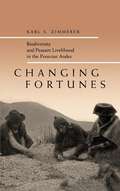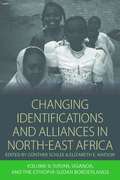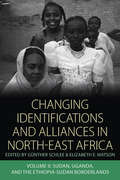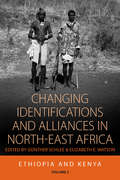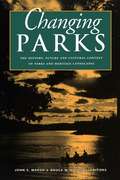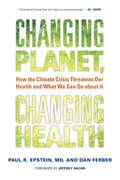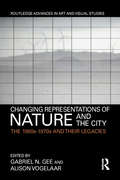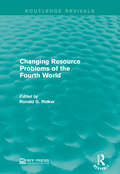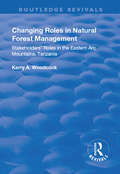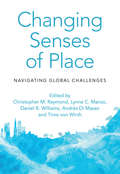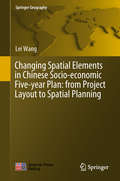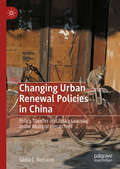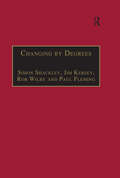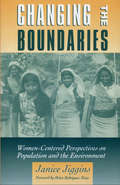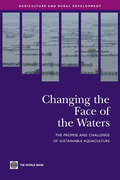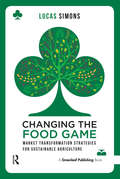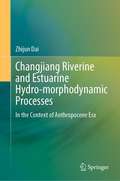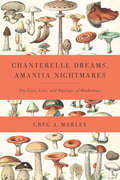- Table View
- List View
Changing Climates, Ecosystems and Environments within Arid Southern Africa and Adjoining Regions: Palaeoecology of Africa 33 (Palaeoecology of Africa)
by Jürgen RungeThis book is volume 33 of the yearbook seriesPalaeoecology of Africa presenting the outcome of atribute conference to the internationally recognized South African researcher and palynologist Professor Louis Scott. He has recently retired, but is continuing his active research career. The conference proceedings and articles published here
Changing Earth
by Janette SchusterNIMAC-sourced textbook <p><p> Changing Earth introduces students to the earth science concept of how the distinct features of Earth came to be.
Changing Fortunes: Biodiversity and Peasant Livelihood in the Peruvian Andes (California Studies in Critical Human Geography #1)
by Karl S. ZimmererTwo of the world's most pressing needs—biodiversity conservation and agricultural development in the Third World—are addressed in Karl S. Zimmerer's multidisciplinary investigation in geography. Zimmerer challenges current opinion by showing that the world-renowned diversity of crops grown in the Andes may not be as hopelessly endangered as is widely believed. He uses the lengthy history of small-scale farming by Indians in Peru, including contemporary practices and attitudes, to shed light on prospects for the future. During prolonged fieldwork among Peru's Quechua peasants and villagers in the mountains near Cuzco, Zimmerer found convincing evidence that much of the region's biodiversity is being skillfully conserved on a de facto basis, as has been true during centuries of tumultuous agrarian transitions.Diversity occurs unevenly, however, because of the inability of poorer Quechua farmers to plant the same variety as their well-off neighbors and because land use pressures differ in different locations. Social, political, and economic upheavals have accentuated the unevenness, and Zimmerer's geographical findings are all the more important as a result. Diversity is indeed at serious risk, but not necessarily for the same reasons that have been cited by others. The originality of this study is in its correlation of ecological conservation, ethnic expression, and economic development.
Changing Identifications And Alliances In North-east Africa
by Günther Schlee Elizabeth E. WatsonForms of group identity play a prominent role in everyday lives and politics in north-east Africa. These volumes provide an interdisciplinary account of the nature and significance of ethnic, religious, and national identity in north-east Africa. Case studies from Sudan, Ethiopia, Uganda, and Kenya illustrate the way that identities are formed and change over time, and how local, national, and international politics are interwoven. Specific attention is paid to the impact of modern weaponry, new technologies, religious conversion, food and land shortages, international borders, civil war, and displacement on group identities. Drawing on the expertise of anthropologists, historians and geographers, these volumes provide a significant account of a society profoundly shaped by identity politics and contribute to a better understanding of the nature of conflict and war, and forms of alliance and peacemaking, thus providing a comprehensive portrait of this troubled region.
Changing Identifications And Alliances In North-east Africa
by Günther Schlee Elizabeth E. WatsonForms of group identity play a prominent role in everyday lives and politics in northeast Africa. Case studies from Sudan, Ethiopia, Uganda, and Kenya illustrate the way that identities are formed and change over time, and how local, national, and international politics are interwoven. Specific attention is paid to the impact of modern weaponry, new technologies, religious conversion, food and land shortages, international borders, civil war, and displacement on group identities. Drawing on the expertise of anthropologists, historians and geographers, these volumes provide a significant account of a society profoundly shaped by identity politics and contribute to a better understanding of the nature of conflict and war, and forms of alliance and peacemaking, thus providing a comprehensive portrait of this troubled region.
Changing Identifications And Alliances In North-east Africa
by Günther Schlee Elizabeth E. WatsonForms of group identity play a prominent role in everyday lives and politics in northeast Africa. Case studies from Sudan, Ethiopia, Uganda, and Kenya illustrate the way that identities are formed and change over time, and how local, national, and international politics are interwoven. Specific attention is paid to the impact of modern weaponry, new technologies, religious conversion, food and land shortages, international borders, civil war, and displacement on group identities. Drawing on the expertise of anthropologists, historians and geographers, these volumes provide a significant account of a society profoundly shaped by identity politics and contribute to a better understanding of the nature of conflict and war, and forms of alliance and peacemaking, thus providing a comprehensive portrait of this troubled region.
Changing Parks: The History, Future and Cultural Context of Parks and Heritage Landscapes
by Bruce W. Hodgins John S. MarshThis important book is a must for everyone concerned with the heritage and future of Canada’s parks. Contributors include an impressive assembly of noted park experts ranging from academic authorities and government parks personnel to concerned nonpolitical park supporters. Since the establishment of Banff National Park in 1885 and Algonquin Provincial Park in 1893, parklands have been part of Canada’s heritage. Where other protected areas, such as forest reserves, heritage rivers and greenways, have also been created, a more comprehensive view of the creation and management of conservation areas and marshland is discussed. Cooperative approaches to park management recognize the regional context of parks with respect to local communities, as well as the inclusion of more diverse groups of people, particularly Aboriginals. This work encourages the general public to take an interest in our priceless park heritage.
Changing Patterns in Israel Agriculture (Routledge Library Editions: Agriculture #6)
by Haim HalperinFirst published in 1957. This study sought to analyse the problems raised by the changing forces and conditions in Israel in the middle of the twentieth-century. It discusses the impact of Israel’s achievement of political sovereignty upon its agricultural economy in the comparatively short space of six years. It examines the agricultural problems that arose as functions of the natural factors of production – land, water, climate, etc. It endeavoured to assess new and better possibilities of farming. This title will be of interest to students of geography and agriculture.
Changing Planet, Changing Health: How the Climate Crisis Threatens Our Health and What We Can Do About It
by Paul R. Epstein Dan Ferber Jeffrey SachsClimate change is now doing far more harm than marooning polar bears on melting chunks of ice--it is damaging the health of people around the world. Brilliantly connecting stories of real people with cutting-edge scientific and medical information, Changing Planet, Changing Health brings us to places like Mozambique, Honduras, and the United States for an eye-opening on-the-ground investigation of how climate change is altering patterns of disease. Written by a physician and world expert on climate and health and an award-winning science journalist, the book reveals the surprising links between global warming and cholera, malaria, lyme disease, asthma, and other health threats. In clear, accessible language, it also discusses topics including Climategate, cap-and-trade proposals, and the relationship between free markets and the climate crisis. Most importantly, Changing Planet, Changing Health delivers a suite of innovative solutions for shaping a healthy global economic order in the twenty-first century.
Changing Representations of Nature and the City: The 1960s-1970s and their Legacies (Routledge Advances in Art and Visual Studies)
by Gabriel N. Gee Alison VogelaarThe turn of the 1960s-70s, characterized by the rapid acceleration of globalization, prompted a radical transformation in the perception of urban and natural environments. The urban revolution and related prospect of the total urbanisation of the planet, in concert with rapid population growth and resource exploitation, instigated a surge in environmental awareness and activism. One implication of this moment is a growing recognition of the integration and interconnection of natural and urban entities. The present collection is an interdisciplinary inquiry into the changing modes of representation of nature in the city beginning from the turn of the 1960s/70s. Bringing together a number of different disciplinary approaches, including architectural studies and aesthetics, heritage studies and economics, environmental science and communication, the collection reflects upon the changing perception of socio-natures in the context of increasing urban expansion and global interconnectedness as they are/were manifest in specific representations. Using cases studies from around the globe, the collection offers a historical and theoretical understanding of a paradigmatic shift whose material and symbolic legacies are still accompanying us in the early 21st century.
Changing Resource Problems of the Fourth World (Routledge Revivals)
by Ronald G. RidkerClimbing food, fertiliser and mineral prices as well as the Arab oil embargo in the seventies had severe economic consequences in developing countries. Originally published in 1976, this study explores the effects of these developments in the fourth world and how they can adjust to an international economy with a particular focus on resource availability in terms of energy and agriculture. This title will be of interest to students of Environmental Studies.
Changing Roles in Natural Forest Management: Stakeholders' Role in the Eastern Arc Mountains, Tanzania
by Kerry A WoodcockThis title was first published in 2002. The paramount question facing natural resource management is how to develop sustainable management approaches. Illustrated by an in-depth study of the Eastern Arc Mountains of Tanzania, this volume examines the role of community in the management of natural resources along with stakeholders' rights, responsibilities and relationships to the forest. The author: reviews the significance of natural forest in the Eastern Arc; identifies changing forest management approaches in Tanzania; identifies stakeholders in natural forest management and whether they are primary or secondary stakeholders; examines historical imbalances in stakeholders' roles and relations between stakeholders; and draws conclusions on the effect of imbalances in stakeholders' roles on the development of sustainable forest management practices in the Eastern Arc.
Changing Senses of Place: Navigating Global Challenges
by Daniel R. Williams Lynne C. Manzo Christopher M. Raymond Andrés Di Masso Timo Von WirthGlobal challenges ranging from climate change and ecological regime shifts to refugee crises and post-national territorial claims are rapidly moving ecosystem thresholds and altering the social fabric of societies worldwide. This book addresses the vital question of how to navigate the contested forces of stability and change in a world shaped by multiple interconnected global challenges. It proposes that senses of place is a vital concept for supporting individual and social processes for navigating these contested forces and encourages scholars to rethink how to theorise and conceptualise changes in senses of place in the face of global challenges. It also makes the case that our concepts of sense of place need to be revisited, given that our experiences of place are changing. This book is essential reading for those seeking a new understanding of the multiple and shifting experiences of place.
Changing Spatial Elements in Chinese Socio-economic Five-year Plan: From Project Layout To Spatial Planning (Springer Geography)
by Lei WangAs a legacy of the socialist state with central planning, Five-Year Planning (FYP) is very important in regulating socio-economic and spatial development even in post-reform China. This book tries to fill the research gap between examining the role of FYP and how spatial elements in the FYP mechanism have operated and transformed in spatial regulatory practices in transitional China. By building a conceptual framework and studying two empirical cases at different spatial scales, with the help of both qualitative and quantitative methods, it helps to understand various stakeholders, institutions and planning administrations, mechanisms of articulating spatial planning into the FYP system and the effectiveness of spatial planning in solving place-specific governance issues in urban and regional China.
Changing Urban Renewal Policies in China: Policy Transfer and Policy Learning under Multiple Hierarchies
by Giulia C. Romano"This is a very rich monograph, based on impressive fieldwork in China, which demonstrates excellent qualitative and ethnographic research skills, research integrity, and cultural perceptiveness in the analysis. This book will make a great contribution to the literature on policy transfer and and policy mobilities, and on urban politics in contemporary China, as it offers a rich understanding of the nitty-gritty practices of transferring and learning 'from abroad'."Claire Colomb, Professor of Urban Studies and Planning at the University College London, UK.This book explores the concept of Careful Urban Renewal, a concept of urban renewal that originated in Berlin in the 1980s and that was proposed to Yangzhou, a Chinese city of the wealthy province of Jiangsu, in the early 2000s. It sets out to understand whether knowledge and ideas originating in a specific setting can be transferred to another locality thousands of miles away from the point of origin, and have the chance to change the policies and the practices of the destination city. The book shows that foreign ideas can inspire ambitious reforms of the policies of a single city, but that there also exist multiple challenges to policy learning and to the rooting of new ideas in local practices. To explore these challenges, this book develops an analysis of the micro-dynamics of policy transfer, showing that there exist multiple hierarchies to which a Chinese city can be subjected, intermittently opening or closing “windows for policy learning”.
Changing by Degrees: The Potential Impacts of Climate Change in the East Midlands (Routledge Studies in Environmental Policy and Practice)
by Paul Fleming Simon Shackley Jim KerseyIt is now accepted that the world’s climate has warmed by about 0.5°C over the past one hundred years and will continue to warm by as much as 6°C by the end of the current century. What, however, do such fundamental changes actually mean for life and the economy at the local and regional scales for the industrialized nations? This extensive study represents a state-of-the-art regional assessment of the impacts of climate change in an industrialized European nation. Providing a comprehensive set of tools, techniques and strategies, it explores the potential impacts of climate change upon key landscapes, economic and social sectors.
Changing our Environment, Changing Ourselves: Nature, Labour, Knowledge and Alienation
by James S. OrmrodIn this book, a celebration of the work of the sociologist Peter Dickens serves as the catalyst for exploring the relationship between human 'internal nature' (our health and psychological well-being) and 'external nature' (the environment on which we depend and which we collectively transform). Across contributions from Ted Benton, James Ormrod, Kate Soper, John Bellamy Foster and Brett Clark, Graham Sharp, James Addicott, Kathryn Dean and Peter Dickens himself, the book draws attention to alienation associated with the promotion of different knowledges in late capitalist production. But it also highlights the possibilities for generating less alienated relations with our environment in the future. As well as discussing the philosophical and theoretical issues involved, the book contains contemporary case studies of ultra-processed food, satellite farming, computerised thinking and dark tourism.
Changing the Boundaries: Women-Centered Perspectives On Population And The Environment
by Janice JigginsChanging the Boundaries explores gender relations with respect to education, reproductive health services, and agricultural resources -- three factors that are widely recognized as being central to the struggle for gender equity, population control, and environmental sustainability. As well as defining the role of women in the population-environment quandary, author Janice Jiggins explains how that role is the key to understanding issues of population and environment. Throughout the volume, she makes extensive use of research, experience, and documentation that draws on the views and publications of women in the global South, much of which is available to development practitioners but is rarely found in academic libraries. Data, arguments, concepts, and analysis from a wide and varied range of sources are woven together to link the experience of women's daily lives with population policies and global environmental politics.
Changing the Face of the Waters: The Promise and Challenge of Sustainable Aquaculture
by World BankAquaculture--the farming of fish and aquatic plants--has become the world's fastest-growing food production sector, even as the amount of wild fish caught in our seas and fresh waters declines. From fish foods and pharmaceuticals to management of entire aquatic ecosystems, acquaculture is truly changing the face of the waters. Increased growth, however, brings increased risk, and aquaculture now lies at a crossroads. One direction points toward the giant strides in productivity, industry concentration, and product diversification. Another direction points toward the dangers of environmental degradation and the marginalization of small fish farmers. Yet another direction invites aquaculture to champion the poor and provide vital environmental services to stressed aquatic environments. 'Changing the Face of the Waters' offers a cutting-edge analysis of the critical challenges facing aquaculture, balancing aquaculture's role in economic growth with the need for sound management of natural resources. The book also provides guidance on sustainable aquaculture by evaluating alternative development pathways, placing particular emphasis on the application of lessons from Asia to Sub-Saharan Africa and Latin America. Aimed at policy makers, planners, and scientists, this book provides a comprehensive frame of reference for orienting ideas and initiatives in this dynamic industry.
Changing the Food Game: Market Transformation Strategies for Sustainable Agriculture
by Lucas SimonsBy 2050, the world’s population is estimated to grow to 10 billion. To feed everyone, we will have to double our food production, to produce more food in the next 40 years than in the whole of the last 6,000. Changing the Food Game shows how our unsustainable food production system cannot support this growth. In this prescient book, Lucas Simons argues that the biggest challenge for our generation can only be solved by effective market transformation to achieve sustainable agriculture and food production. Lucas Simons explains clearly how we have created a production and trading system that is inherently unsustainable. But he also demonstrates that we have reason to be hopeful – from a sustainability race in the cocoa industry to examples of market transformation taking place in palm oil, timber, and sugarcane production. He also poses the question: where next? Provocative and eye-opening, Changing the Food Game uncovers the real story of how our food makes it on to our plates and presents a game-changing solution to revolutionize the industry.
Changing the Game: Sustainable Market Transformation Strategies to Understand and Tackle the Big and Complex Sustainability Challenges of Our Generation
by Lucas Simons Andre NijhofWe are at the beginning of the sustainability era. The biggest challenge of our generation is to reach the Sustainable Development Goals. For this we must be willing to understand and change the root causes that create these challenges in the first place. The system itself needs to change. But how to do that? This ground-breaking book Changing the Game reveals the missing insights and strategies to actually achieve system change. The authors Lucas Simons and André Nijhof bring decades of real life and academic experience, and state that most of the sustainability challenges are actually caused by the same system failures, every time. Therefore, the way to accelerate and manage system change is also similar every time – if you know where to look and how to act. The theory of sustainable market transformation and system change is described in a compelling and easy to understand eight-step approach applied to eight different sectors. The authors, together with respected sector experts, describe the drivers, triggers and dominant thinking in each of these sectors as well as the strategies needed to move towards higher levels of sustainability. This book is highly accessible and engaging, and is perfect for use by professionals, leaders and students for understanding how to move markets to a more sustainable future.
Changjiang Riverine and Estuarine Hydro-morphodynamic Processes: In the Context of Anthropocene Era
by Zhijun DaiThis book provides a comprehensive and systematic analysis of the morphodynamic process of the Changjiang River from upstream to estuary in the Anthropocene. As the longest river in China, the Changjiang River has nurtured Chinese civilization with ample natural resources for thousands of years. Evidence highlights that the Changjiang River has experienced intensive human interference and indicated dramatic changes in the Anthropocene, including “no flood in flood season, no dry in dry season” in discharge; “less flood in flood season, more dry in dry season” in sediment; riverbed shifts from accretion to erosion; lakes in the middle-lower reach turn from sediment sink to source; estuarine tidal flat exhibits self-organization characteristics and maintains the current accretion state; estuarine branches that connect to the sea show district morphodynamic patterns; and depocenters of the submerged delta indicate periodic shifts. The book stresses that dam construction upstream, practically the Three Gorges Dam, the world’s largest hydraulic engineering project, has significant influences on the hydrology and geomorphology of the middle-lower reach but has a slight effect on estuarine delta development. The geomorphological structure of the estuarine channel is dominated by local land reclamation, navigation, and dredging. This book clarifies the river-estuary morphodynamics of the Changjiang River and indicates the general features of global mega rivers under human interference as well as their own response mechanisms. This book also exhibits the potential risk of river-estuary deltas in the future, as both material and dynamics are experiencing acceleration adjustment.
Chanterelle Dreams, Amanita Nightmares: The Love, Lore, and Mystique of Mushrooms
by Greg Marley*Winner, International Association of Culinary Professionals Jane Grigson Award*Finalist, International Association of Culinary Professionals in the Culinary History categoryThroughout history, people have had a complex and confusing relationship with mushrooms. Are fungi food or medicine, beneficial decomposers or deadly &“toadstools&” ready to kill anyone foolhardy enough to eat them? In fact, there is truth in all these statements. In Chanterelle Dreams, Amanita Nightmares, author Greg Marley reveals some of the wonders and mysteries of mushrooms, and our conflicting human reactions to them.With tales from around the world, Marley, a seasoned mushroom expert, explains that some cultures are mycophilic (mushroom-loving), like those of Russia and Eastern Europe, while others are intensely mycophobic (mushroom-fearing), including, the US. He shares stories from China, Japan, and Korea-where mushrooms are interwoven into the fabric of daily life as food, medicine, fable, and folklore-and from Slavic countries where whole families leave villages and cities during rainy periods of the late summer and fall and traipse into the forests for mushroom-collecting excursions.From the famous Amanita phalloides (aka &“the Death Cap&”), reputed killer of Emperor Claudius in the first century AD, to the beloved chanterelle (cantharellus cibarius) known by at least eighty-nine different common names in almost twenty-five languages, Chanterelle Dreams, Amanita Nightmares explores the ways that mushrooms have shaped societies all over the globe.This fascinating and fresh look at mushrooms-their natural history, their uses and abuses, their pleasures and dangers-is a splendid introduction to both fungi themselves and to our human fascination with them. From useful descriptions of the most foolproof edible species to revealing stories about hallucinogenic or poisonous, yet often beautiful, fungi, Marley&’s long and passionate experience will inform and inspire readers with the stories of these dark and mysterious denizens of our forest floor.
Chaos Theory Tamed
by Garnett WilliamsThis text aims to bridge the gap between non-mathematical popular treatments and the distinctly mathematical publications that non- mathematicians find so difficult to penetrate. The author provides understandable derivations or explanations of many key concepts, such as Kolmogrov-Sinai entropy, dimensions, Fourier analysis, and Lyapunov exponents.



